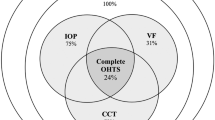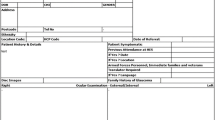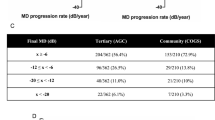Abstract
Glaucoma is a leading cause of vision loss and blindness worldwide, especially among the elderly. While there are many forms of glaucoma, there are 2 major groups: ‘open-angle’ (OAG) and ‘angle closure’. The latter is now successfully treated by laser iridotomy. The former, OAG, is a chronic condition that accounts for the majority of glaucomas in developed countries. For both major groups of glaucoma, different management guidelines exist.
Both the American Academy of Ophthalmology (AAO) and the American Optometric Association (AOA) have guidelines which cover both groups of glaucoma. Comparison of these guidelines reveals striking similarity, suggesting relative uniformity of professional opinion regarding ‘best practice’ care of patients with glaucoma. However, there are a few important differences between the 2 guidelines promulgated by the 2 organisations.
For OAG, the most important and striking difference is in the criteria for case identification and case severity classification. The AAO uses, essentially, an optic nerve head criteria for case identification and then classifies severity according to visual field criteria only. In contrast, the AOA uses both optic nerve and visual field criterion to both make a diagnosis and to classify the severity of disease. Related to this, early glaucoma in the AAO classification is explicitly glaucoma without any visual field loss, whereas the AOA classification of early glaucoma is already equivalent to at least moderate glaucoma in the AAO scheme. Additional differences between both guidelines centre mostly on more intensive use of services and testing in the optometric guidelines.
Little data have been published to date on whether or not care provided to patients conforms to these guidelines. What has been described indicates relatively good compliance with most elements of care, but with major deficiencies in some important aspects of care i. e. the content of care and the follow-up nature of care. As such, significantly more work needs to be undertaken to better provide care to patients with glaucoma.
Similar content being viewed by others

References
Quigley HA. Number of people with glaucoma worldwide. Br J Ophthalmol 1996; 80: 389–93
Marshall EC. Racial differences in the presentation of chronic open-angle glaucoma. J Am Optom Assoc 1989; 60: 760–67
Van Newkirk MR. The Hong Kong vision study: a pilot assessment of visual impairment in adults. Trans Am Ophthalmol Soc 1997; 95: 715–49
Singh MM, Murthy GV, Venkatraman R, et al. A study of ocular morbidity among elderly population in a rural area of central India. Indian J Ophthalmol 1997; 45: 61–5
Tielsch JM. The epidemiology and control of open angle glaucoma: a population-based perspective. Ann Rev Public Health 1996; 17: 121–36
American Optometric Association. Care of the patient with primary angle closure glaucoma. St Louis (MO): American Optometric Association, 1994
American Optometric Association. Care of the patient with open angle glaucoma. St Louis (MO): American Optometric Association, 1995
American Academy of Ophthalmology. Preferred practice pattern: primary open-angle glaucoma. San Francisco (CA): American Academy of Ophthalmology, 1996
American Academy of Ophthalmology. Preferred practice pattern: primary angle-closure glaucoma. San Francisco (CA): American Academy of Ophthalmology, 1996
Lee PP, Jackson CJ, Relies DA. Estimating eye care provider workforce. Ophthalmology 1995; 102: 1964–72
Lee PP. The effect of preferred practice patterns on malpractice actions. J Glaucoma 1992; 1: 286–9
Quigley HA. Open angle glaucoma. N Engl J Med 1993; 328: 1097–106
Albrecht K, Lee PP. Conformance with preferred practice patterns in glaucoma care. Ophthalmology 1994; 101: 1036–43
Hertzog LH, Albrecht KG, LaBree L, et al. Glaucoma care and conformance with preferred practice patterns: examination of the private, community-based ophthalmologist. Ophthalmology 1996; 103: 1009–13
Playfair TJ, Watson PG. Management of acute primary angle-closure glaucoma: a long term follow-up of the results of peripheral iridectomy used as an initial procedure. Br J Ophthalmol 1979; 63: 17–22
Del Priore LV, Robin AL, Pollack IP. Neodynium-YAG and argon laser iridotomy. Long-term follow-up in a a prospective, randomized clinical trial. Ophthalmology 1988; 95: 1207–11
Hattenhauer MG, Johnson DH, Ing HH, et al. The probability of blindness from open-angle glaucoma. Ophthalmology 1998; 105: 2099–104
Author information
Authors and Affiliations
Corresponding author
Additional information
About the Author: Dr Paul Lee is Professor of Ophthalmology at Duke University Medical School, Durham, North Carolina, and a Consultant with the Health Sciences Program at RAND, Santa Monica, California, USA. Dr Lee is also the methodologist for the American Academy of Ophthalmology Preferred Practice Pattern Committee for glaucoma. His research interests are in healthcare delivery and health services research, as well as the surgical treatment of complicated glaucomas.
Rights and permissions
About this article
Cite this article
Lee, P. Use of Guidelines in the Management of Patients With Glaucoma. Dis-Manage-Health-Outcomes 5, 187–195 (1999). https://doi.org/10.2165/00115677-199905040-00001
Published:
Issue Date:
DOI: https://doi.org/10.2165/00115677-199905040-00001



